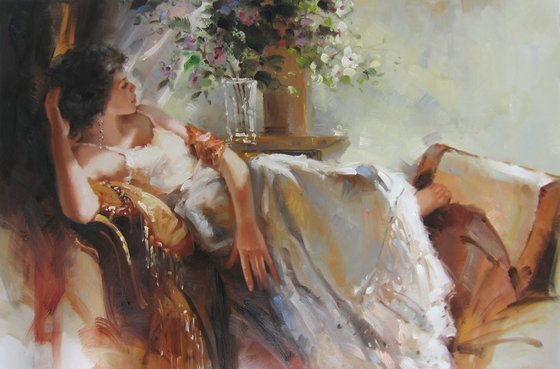Oil Paintings for Sale to Elevate Any Interior Space
Oil Paintings for Sale to Elevate Any Interior Space
Blog Article
Checking out All Concerning Oil Paintings: A Guide to Comprehending Their Elegance and Worth
Oil paintings have actually mesmerized target markets for centuries, supplying a glance right into the imaginative proficiency of different eras. Their rich background is linked with cutting-edge strategies and profound emotional expression. Recognizing the products and approaches behind these art work can enhance admiration. In addition, the market for oil paintings presents chances for enthusiasts and investors alike. As one discovers this interesting world, the question emerges: what makes an oil paint truly beneficial?
The Background of Oil Painting: A Trip Through Time
Although oil paint has roots that date back to ancient times, it truly prospered during the Renaissance, when musicians uncovered its adaptability and rich color possibility. Early instances can be traced to the 7th century, with strategies advancing significantly throughout cultures. The tool became noticeable in Northern Europe in the 15th century, especially through the jobs of artists like Jan van Eyck, that pioneered its use for in-depth realism and lively hues. This period noted a separation from tempera paints, enabling better depth and structure. As oil paint spread, it affected numerous musicians, resulting in work of arts by popular numbers such as Leonardo da Vinci and Rembrandt. The tool's legacy proceeds, forming the art globe well into contemporary times.
Understanding Oil Repaints: Materials and Techniques
As artists check out the globe of oil paints, they encounter a diverse variety of products and strategies that specify this medium. The primary elements of oil paint consist of pigments, which give shade, and drying oils, such as linseed, that bind the pigments and help with application. Different ingredients can customize the paint's appearance and drying out time, boosting flexibility. Methods like glazing, where clear layers are accumulated, and impasto, which entails using thick paint, allow for various visual results. Furthermore, the usage of brushes, combination knives, and also fingers can produce one-of-a-kind appearances and coatings. Understanding these materials and techniques makes it possible for musicians to totally share their imagination and accomplish the preferred effect in their artwork.
The Role of Color in Oil Paints
Color plays a crucial function in oil paintings, affecting both visual appeal and psychological resonance. Understanding shade concept basics, including the partnerships in between tones, can improve an artist's capability to communicate mood and atmosphere. In addition, grasping color blending methods enables higher depth and splendor in a paint's combination.

Shade Theory Basics
Understanding shade concept is important for musicians dealing with oil paints, as it develops the foundation for developing visually interesting and unified make-ups. Shade theory includes the study of just how colors interact, the shade wheel, and the relationships in between key, additional, and tertiary shades. Musicians use complementary shades to improve contrasts and create centerpieces, while similar shades promote unity and cohesiveness within a piece. In addition, the principles of great and cozy shades affect the perception of deepness and space in a paint. Comprehending these principles enables musicians to manipulate shade effectively, assisting the viewer's eye and interacting their intended message. Mastery of shade concept ultimately enhances a musician's ability to communicate feelings and ideas via their work.
Psychological Impact of Shade
The psychological effect of color in oil paints plays a crucial duty in just how customers attach and perceive with artwork. Colors stimulate details feelings and moods, affecting the viewer's emotion. For example, warm shades like oranges and reds can create a feeling of heat and energy, while great tones such as blues and greens commonly stimulate calmness or self-questioning. Artists tactically pick shade schemes to boost narrative components, leading the target market's psychological trip. The saturation and comparison of colors even more enhance these impacts, drawing attention and creating emphasis. Eventually, the interaction of shades in oil paintings not just enhances their aesthetic appeal but likewise serves as a powerful medium for psychological expression, enriching the customer's experience and interpretation.
Color Combining Techniques
While several facets of oil paint add to the general composition, mastering shade blending strategies is vital for achieving desired results and deepness. Shade blending can be come close to through various methods, consisting of the subtractive and additive procedures. Additive mixing involves incorporating shades of light, while subtractive mixing depends on pigments, where colors mix to develop new shades. Artists often utilize a minimal scheme to create unified works, understanding the partnerships in between primary, additional, and tertiary colors. Strategies such as glazing and scumbling even more enhance deepness and luminosity. By masterfully blending shades, an artist can evoke feelings, produce centerpieces, and achieve a feeling of realistic look, eventually raising the painting's emotional and visual influence.
Famous Oil Painters and Their Iconic Works

Well known for their mastery of shade and strategy, oil painters have produced some of one of the most celebrated art work in history. Renowned musicians like Vincent van Gogh captivated target markets with his stirring brushwork in "Starry Evening," while Claude Monet's "Perception, Daybreak" prepared for Impressionism. Leonardo da Vinci's "Mona Lisa" remains an enduring symbol of artistic genius, showcasing his skill in capturing human expression. On the other hand, Rembrandt's "The Night Watch" shows his cutting-edge use light and darkness. Other noteworthy figures include Pablo Picasso, that revolutionized modern art with his vibrant trial and error in jobs like "Les Demoiselles d'Avignon," and Georgia O'Keeffe, whose vivid representations of flowers and landscapes helped specify American innovation. Each artist's distinct style added considerably to the oil paint landscape.
Exactly how to Review the Top Quality of an Oil Paint
Reviewing the high quality of an oil paint entails a cautious analysis of workmanship techniques, as well as an evaluation of color and composition. Observing brushwork, layering, and the application of paint can disclose the artist's skill degree. Furthermore, the interplay of shades and the general arrangement of components contribute considerably to the paint's aesthetic worth.
Evaluating Craftsmanship Strategies
A careful assessment of workmanship techniques is essential for establishing the top quality of an oil painting. Critics ought to initially take a look at the application of paint; thick, textured brushstrokes might suggest a competent hand, while overly uniform applications could suggest an absence of here depth. oil paintings for sale. The layering strategy is also crucial; the presence of lusters and varied thickness can enhance brightness and intricacy. In addition, the quality of the products utilized, such as the canvas and pigments, plays a considerable function in toughness and total visual. Interest to information in elements like edges and shifts between colors mirrors the artist's dedication to their craft. Ultimately, these methods add to the painting's emotional effect and market worth, functioning as signs of the musician's skill and intent
Evaluating Color and Make-up
While reviewing the top quality of an oil painting, one should focus on the interaction of color and structure, as these aspects are essential to the art work's general impact. Color choices can stimulate emotions and develop mood; for that reason, the artist's scheme should be analyzed for harmony and contrast. A healthy composition guides the audience's eye and produces a sense of unity. Musicians usually employ techniques like the regulation of thirds or leading lines to enhance visual rate of interest. Furthermore, making use of light and shadow can include deepness, improving the three-dimensionality of the paint. Inevitably, an effective oil painting marries color and structure, engaging the audience and welcoming a deeper recognition of the artist's vision and technique.
Caring for and Preserving Oil Paintings
Proper care and preservation of oil paints is necessary for preserving their honesty and long life. To shield these art work, it is vital to show them far from straight sunlight, which can trigger fading and discoloration. Maintaining a secure environment with controlled temperature and humidity additional help in preventing damages. Cleaning up ought to be done delicately utilizing a soft, completely dry towel, staying clear of any kind of harsh chemicals that can harm the paint or varnish. Routine assessments for indicators of wear and tear, such as flaking or splitting, are recommended. When saving or carrying oil paintings, proper padding and framing are required to avoid physical damage. Eventually, attentive care adds to the aesthetic appeal and value of oil paints in time.
The Marketplace for Oil Paints: Gathering and Spending
Comprehending the marketplace characteristics for oil paints is necessary for enthusiasts and capitalists alike. The value of these artworks is influenced by numerous factors, consisting of the musician's track record, historical significance, and present trends. Collectors often look for items that resonate personally while thinking about possible admiration in worth. Auctions and galleries act as main venues for trading, with prices rising and fall based on need and rarity. Spending in oil paintings needs research right into the market, as well as an understanding of authenticity and provenance. Furthermore, arising artists may provide opportunities for considerable returns, while developed names can regulate high prices. In general, a calculated method to gathering can generate both aesthetic pleasure and financial rewards.

Frequently Asked Concerns
What Are the Ecological Influences of Oil Paint Materials?
The ecological influences of oil painting materials include the launch of volatile natural compounds (VOCs), unsafe waste generation, and resource extraction for pigments. These variables add to air pollution and environmental destruction, elevating concerns among ecologically mindful musicians and consumers.
How Do Various Canvases Impact Oil Painting Results?
Different canvases influence oil paint results considerably. Absorbency, structure, and surface area quality can change paint application, drying out times, and shade vibrancy. Artists often pick specific canvases to accomplish preferred impacts and boost their imaginative expression.
Can Oil Paintings Be Restored if Harmed?
If harmed, Oil paintings can indeed be recovered. Professional conservators use different techniques to repair splits, tidy surfaces, and address staining, ensuring that the art work maintains its original elegance and value for future generations.
What Are the Indications of an Original Oil Paint?
The signs of an original oil painting consist of noticeable brush strokes, appearance variations, and an unequal canvas weave (oil paintings for sale). Additionally, authenticity might be confirmed with provenance, trademarks, and the presence of a varnish layer unique to oil mediums
Just How Has Technology Influenced Modern Oil Painting Techniques?
Technology has actually considerably affected contemporary oil painting strategies by presenting digital tools for preparation, enhanced products for appearance and longevity, and online platforms for marketing and sharing art, thereby broadening musicians' innovative opportunities and audience reach. Oil paint has roots that date back to old times, it absolutely prospered throughout the Renaissance, when artists discovered its adaptability and rich shade possibility. The emotional impact of shade in oil paints plays a crucial function in how viewers regard and connect with art work. While lots of aspects of oil paint add to the general structure, mastering shade blending methods is important for attaining wanted results and deepness. Examining the quality of an oil paint entails a careful evaluation of craftsmanship techniques, as well as an analysis of color and structure. While evaluating the top quality of an oil painting, one must concentrate on the interaction of color and structure, as these components are basic to the artwork's total influence.
Report this page